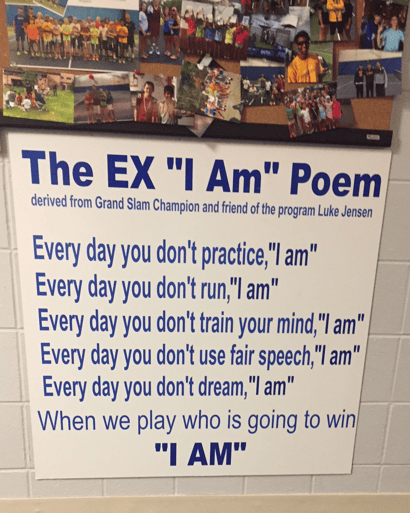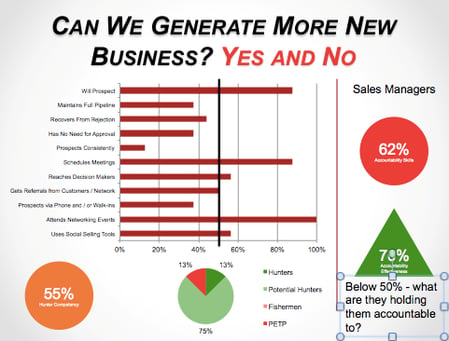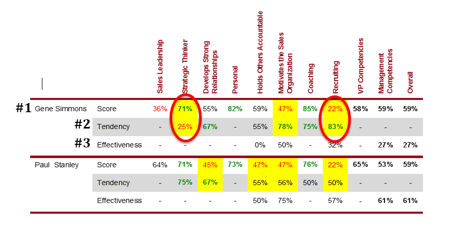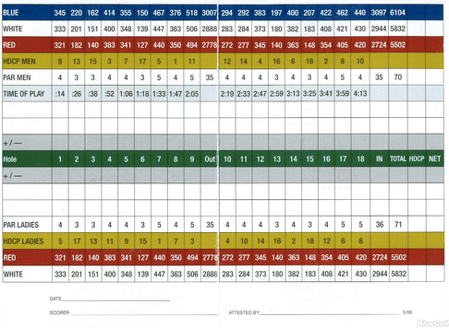QUESTIONS THAT COMPANIES NEED TO ANSWER
As many of you know, we use the Objective Management Group's (OMG) assessment to evaluate every organization that we do sales and sales management training, coaching and consulting for. The process helps us (and helps our clients) determine with great accuracy the answers to these 4 questions:
- Can we be more effective (sell more, more quickly at better margins)?
- How much more effective could we be?
- What would it take?
- How long would it take?
Answering these four questions requires the ability to uncover at least two important contributors to improved effectiveness:
- Their “will” to improve in selling and sales management
- Their ability (sales and sales management DNA)
6 FACTORS THAT DETERMINE THE WILL TO SELL
There are 6 known contributing factors that OMG uses to determine “will to sell” (click here for a review of the OMG pre-hire assessment tool).
- Desire to succeed in selling
- Commitment to succeed in selling
- Motivation
- Outlook
- Responsibility
- Enjoyment of selling
A CONSISTENTLY RECURRING QUESTION
I don't believe there is a way to effectively rank those factors in terms of relevant importance. Having used the tool and delivered results to dozens of companies and hundreds of people, my experience is that these 6 work together to form a puzzle that gives you an overall picture of someone’s “will to sell”. In this article, however, I want to focus on motivation because, over and over again, when attending my workshops, attendees consistently the question, “How do I motivate or keep my people motivated?”
FINDING INSPIRATION
I was getting ready to work out at my club the other day and, when walking to the men’s locker room, I stopped and looked at this sign. Now, I’ve seen this sign literally hundreds of times and have read it dozens of times. I have always found it interesting and a bit inspiring.

I can imagine being a young tennis player who has big dreams of playing tennis on a large stage someday. And that young person might take a photo of this poster and put it on their phone, locker room, door or wall at home. They might even post it to social media – Facebook. Twitter, Instagram or Snapchat.
It all depends on that person’s motivation.
This person could be driven by pride, satisfaction, mastery, achievement, competition, enjoyment or recognition. They could even be motivated by the love of winning or that hate of losing. They might just be trying to prove the naysayers wrong!
ARE YOU MOTIVATED?
What motivates you? If you are a manager, what is motivating your people? If you are not motivated to:
- Be more effective
- Be more successful
- Compete to be the best
- Sell more to make your lifestyle dreams a reality
- Make sure your children receive an education without the debt
I have to ask: Why?
ALL ENCOMPASSING - MOTIVATION INVOLVES EVERYTHING
Let me address two things:
- Personal motivation
- Motivation of others
My experience – my own true, personal experience - about motivation is that when you desire something greatly in your heart, then you will live and breath the desire to make the dream a reality. Many of you know I played football at UConn. I always considered myself blessed beyond reason to have had the opportunity to make my dream a reality. But blessed does not stand alone as the only contributing factor for the scholarship. Yes, I had some God-given talents (nature), but I also had some external factors (nurture) that contributed to my success. Those factors were Mom and Dad and the attitudes they instilled in me regarding hard work, anything is possible, don’t give up, success requires commitment. I learned early on that, if you really want to accomplish something great in your life, you must be willing to give up some things to get where you want to go.
- When my classmates were going to Lee’s house to party after a game, I did not.
- I hated vegetables, but my dad told me he would tell Coach Cacia I wasn’t eating right – I wasn’t going to let that happen.
- At the end of a long day – 12 hours – working on the farm, I still ran my miles and lifted weights.
- When I got beat on a certain play during practice, I would make that person pay the price on the next play.
- I ran sprints every day at the end of practice.
- I played hurt.
- I studied and got the grades needed to get into college.
- I did all of those things for 13 years.
MY STARTLING WAKE-UP CALL
On the other side of that coin are the years between 1998 and 2003. Those 5 years are lost to me because of the event of our son's (Anthony) cardiac arrest and subsequent severe brain injury. I could think of nothing but his full recovery to health. Nothing else mattered and it showed up in the shrinking of our business. One day, Linda walked into the office and said, “We need to talk.” I thought it had something to do with Anthony. Instead, she asked, “Are you ever going to start working again?”
Man, did that piss me off!
But, I started to work again because I had new motivation. And that is my point. I believe most people go through stages of motivation. The stages probably look like the side view of a roller coaster – lots of ups and downs. If you find yourself in the down, don’t assume that you will go back up. You may be at the end of the ride. If you are there, you need to find new and different reasons to get back in the seat and ride to the top.
THE REAL DEAL – MOTIVATION IS PERSONAL
When I answer the question - How do I motivate my people? - for workshop attendees, I tell them, “You cannot motivate them. Motivation is an inside-out job and they have to come to the table with their own motivation. The best you can do is create an environment where people want to come and they want to be motivated and excited because they have personal reasons to be successful.”
I remember having a discussion with Tom. Tom was a COO of a large insurance holding company and we were talking about his next day’s presentation to the troops. He told me about his agenda and the key points in the speech. One of the topics was shareholder value. When he finished, I asked permission to ask a question and then make a comment. “Permission granted,” Tom said.
I asked, “How many people in the audience are shareholders?” One, he said.
I then said, “Tom, with all due respect, those people don’t give a rat’s #@% about shareholder value. What they care about is having enough money to retire, pay for a wedding, have the dream vacation, pay for college, and eliminate debt. Talk to them about how the company will support their efforts to make those things happen and then you will have an audience who will listen and respond.”
THESE 3 FAILS = NO MOTIVATION
The problem, in many cases, is that the sales executive in charge of getting more out of the sales team has no idea what motivates those people on the team. Without knowing that, how could you possibly create a motivated environment?
While assessing numerous organizations, we have found three things that hinder the motivation and success of the sales team: 1) 90% of the sales managers don’t believe they need to know what motivates their sales people. 2) 25% of the sales managers are not motivated to be successful in the role of sales manager and 3) Virtually 100% of the salespeople lack personal goals, lack a personal goal plan and fail to have a process in place to track if they are achieving goals.
How could you possibly have a motivated sales team?
ADDITIONAL RESOURCES AVAILABLE:
Motivation Quotes in Unlikely Places – Dave Kurlan
Pavarotti and Motivation – Music and Self Motivation
Robert De Niro Inspiring Speech at NYU School for The Arts - Youtube
Motivation – What Would You Attempt If You Knew You Couldn’t Fail?















